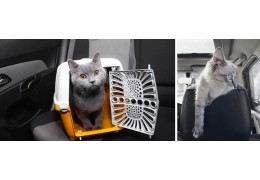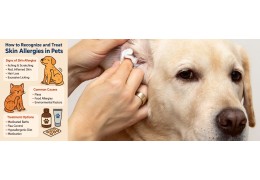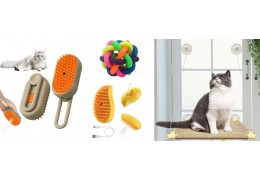Taking your cat on a road trip can be a rewarding experience if you prepare properly. This guide covers essential...
How to Prepare Your Cat for a Road Trip
Planning a road trip with your feline friend can be a rewarding experience, but it requires careful preparation to ensure both your comfort and your cat's safety. Traveling with a cat, especially over long distances, necessitates thoughtful planning to minimize stress and ensure a smooth journey. Whether you're embarking on a short drive or an extended trip, understanding how to travel with your cat in a car is essential. Proper preparation can make the experience enjoyable for both you and your pet.
1. Acclimate Your Cat to the Car
Cats are creatures of habit and often associate car rides with stressful events like vet visits. To change this perception:
Introduce the Car Gradually: Start by allowing your cat to explore the stationary car. Place familiar items like their favorite blanket or toy inside to create a positive association.
Short Practice Drives: Begin with brief trips around the block, gradually increasing the duration as your cat becomes more comfortable. Reward them with treats and affection after each ride to reinforce positive behavior.
Use Calming Sprays: Feliway and other synthetic pheromone sprays can help reduce anxiety by mimicking a cat's natural calming scent.
2. Choose the Right Carrier
A secure and comfortable carrier is vital for your cat's safety during the trip.
Size and Ventilation: The carrier should be spacious enough for your cat to stand, turn around, and lie down comfortably. Ensure it has adequate ventilation.
Familiarization: Leave the carrier open in your home with treats and bedding inside, encouraging your cat to explore and rest in it before the trip.
Secure Placement: Position the carrier in the back seat, secured with a seatbelt, to prevent movement during travel.
3. Visit the Veterinarian
A pre-trip vet visit ensures your cat is healthy and ready for travel.
Health Check: Confirm that vaccinations are up to date and discuss any health concerns.
Travel Advice: Your vet can provide guidance on managing anxiety and recommend sedatives if necessary.
Motion Sickness Prevention: Some cats may experience nausea during car rides. Your vet may suggest anti-nausea medication to help keep your cat comfortable.
4. Pack Essential Supplies
Having the right supplies can make the journey more comfortable for your cat.
Food and Water: Bring your cat's regular food and bottled water to prevent digestive issues. Pack collapsible bowls for easy feeding.
Litter Box: A portable litter box with familiar litter is essential for longer trips.
Comfort Items: Include favorite toys, blankets, and bedding to provide a sense of familiarity.
Grooming Supplies: Pack a brush and pet wipes to keep your cat clean and comfortable.
5. Ensure Identification and Safety
Proper identification is crucial in case your cat gets lost.
ID Tags and Microchipping: Ensure your cat wears a collar with an ID tag and consider microchipping for added security.
Harness and Leash: Train your cat to use a harness and leash for safe breaks outside the car.
Keep Windows Closed: Never leave your cat unattended in the car or allow them to roam freely inside, as sudden movements could lead to accidents.
6. Plan Your Route and Stops
Strategic planning can reduce stress for both you and your cat.
Pet-Friendly Accommodations: Research and book lodgings that welcome cats.
Regular Breaks: Schedule stops every few hours to allow your cat to use the litter box, eat, and stretch.
Avoid High-Traffic Areas: Opt for quieter rest stops where you can safely take your cat out for a break if necessary.
7. Maintain a Calm Environment
A serene atmosphere helps keep your cat relaxed during the trip.
Temperature Control: Keep the car at a comfortable temperature, avoiding extreme heat or cold.
Noise Reduction: Minimize loud music and sudden noises. Speaking softly to your cat can be reassuring.
Cover the Carrier: If your cat is particularly anxious, covering the carrier with a light blanket can create a den-like, secure feeling.
8. Monitor Your Cat's Behavior
Being attentive to your cat's needs ensures their well-being.
Signs of Stress: Panting, excessive meowing, or restlessness may indicate discomfort. If these signs persist, consult a veterinarian.
Hydration and Feeding: Offer water regularly and maintain feeding routines as much as possible.
Litter Box Access: If on an extended trip, provide litter box breaks at safe and enclosed locations.
9. Prepare for Emergencies
Being prepared for unforeseen situations is essential.
Emergency Kit: Include basic first-aid supplies and any medications your cat may need.
Veterinary Contacts: Research veterinary clinics along your route and at your destination.
Pet Insurance: If you have pet insurance, keep a copy of your policy and emergency vet contacts handy.
10. Post-Trip Care
After reaching your destination, help your cat adjust to the new environment.
Safe Space: Set up a quiet area with familiar items where your cat can relax and acclimate.
Supervision: Initially, supervise your cat's exploration to ensure their safety.
Monitor for Stress or Illness: Look for signs of stress or health issues, such as hiding, refusal to eat, or excessive grooming. If any concerning symptoms arise, consult a veterinarian.
11. What to Do If Your Cat Becomes Anxious
If your cat shows signs of anxiety, here are some ways to help calm them:
• Play Soft Music: Classical or calming cat music can soothe an anxious feline.
• Offer Treats and Praise: Reinforce positive behaviors with treats and affection.
• Avoid Frequent Handling: Let your cat settle in the carrier without excessive petting or movement.
12. Benefits of Traveling with Your Cat
While traveling with a cat may require extra effort, it comes with benefits:
• Stronger Bond: Spending extended time together deepens the human-animal bond.
• No Worries About Pet Sitters: You won’t have to stress about leaving your cat behind.
• New Experiences for Your Cat: Some cats adapt well to travel and enjoy exploring new environments.
By following these guidelines, you can ensure a safe and enjoyable road trip with your feline companion. Proper preparation and attentiveness to your cat's needs will make the journey pleasant for both of you. With a little planning, patience, and the right approach, your road trip with your cat can be an exciting adventure that you’ll both enjoy!












